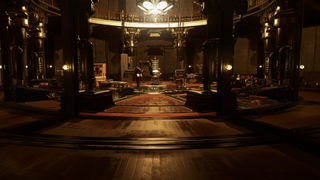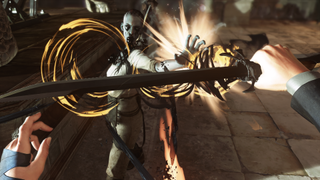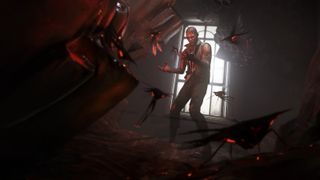Dishonored 2 Review
Steampunk stealth for the more cerebral gamer

Videogames are often criticised as being brainless – invariably by those who never play them. However, nobody dared accuse 2012’s Dishonored of such a failing: an action-adventure game that placed a premium on stealth, inventive magical powers and an intrigue-ridden storyline, set in a baroque, steampunk city inspired by Victorian London called Dunwall.
It was a game that struck a resounding chord among more cerebral gamers.
Now publisher Bethesda Softworks has served up a second instalment in the form of Dishonored 2 and, while it doesn’t differ wildly from its predecessor, it proves to be thoroughly absorbing and entertaining, and feels much more fully realised and coherent than the original.
Political plotting
Story-wise, Dishonored 2 picks up the action 15 years after the end of Dishonored. Emily Kaldwin who, as Royal protector Corvo Attano, you rescued in the first game, is now Empress, reluctantly celebrating the anniversary of the murder of her mother, the previous Empress.
But all is far from well in Dunwall: someone known as the Crown Killer is on the loose, bumping off those who criticised Empress Emily, and the people are pointing the blame squarely at her and Corvo.
Then, at the ceremony itself, a coup takes place: a woman calling herself Delilah Kaldwin, who claims to be Emily’s older sister, seizes the throne and demonstrates some fearsome magical powers in the process.

At that point, you discover one way in which Dishonored 2 diverges from the first game: you must choose whether to play as Emily or Corvo.
Get daily insight, inspiration and deals in your inbox
Get the hottest deals available in your inbox plus news, reviews, opinion, analysis and more from the TechRadar team.
Emily has different powers than Corvo, but is every bit as skilled in the arts of stealth and assassination as him. Whichever you choose, you must escape the palace, stealth your way to Dunwall’s docks, then find a woman called Meagan Foster, an associate of Corvo’s old mate Anton Sokolov, who whisks you away to the city of Karnaca on the southern island of Serkonos, from whence the coup clearly originated.
...the tough get going
Then the proper action begins. Emily or Corvo must perform a succession of pleasingly arcane missions, during which a storyline involving some gloriously decadent and unhinged characters unfolds, in the face of constant hostility.
Karnaca’s inhabitants are routinely hostile to anyone they don’t recognise, and the streets are patrolled by various different hierarchies of guards, who will attack on sight, as will the likes of the street criminals known as Howlers. Parts of the city can only be entered via Walls of Light, which will instantly vaporise you, so you must use your powers to disable or circumvent them.
Many of the story missions take place in specific buildings, such as the Addermire Institute (a forbidding former hospital) or the Clockwork Mansion, home to Kirin Jindosh, who has kidnapped Sokolov and is building an army of Clockwork Soldiers – which are essentially steampunk attack-robots.

Such interior settings are even more heavily guarded than Karnaca’s streets, so you find yourself progressing room-by-room. While Dishonored 2 is rigorously checkpointed, it’s still a good idea to save often.
"One of Dishonored 2’s most appealing – even, at times, breath-taking – features is its environmental design."
One of Dishonored 2’s most appealing – even, at times, breath-taking – features is its environmental design. Karnaca is fabulous to behold as well as being a great place in which to hang out: it’s a bustling, dodgy, colourful city despite the signs of imperial repression on its streets, which feels as real as any you will find in any videogame.
Everyone you meet is doing something, rather than generally milling around, and exploration is fantastically rewarding – there are side-missions on offer which help smooth your path to the main-mission set-pieces, as well as yielding useful weaponry and items.
There’s nothing linear about Dishonored 2, even when you have missions with multiple objectives that you must complete in order. The game contains a number of systems – visibly honed since the first game – that combine to try to thwart you but, within that framework, you really can play however you want.
Both Emily and Corvo have swords which they can wield in a satisfyingly deadly manner (especially once you master blocking, which can be a tiny bit fiddly), as well as superb crossbows (the incendiary bolts are particularly lethal), a pistol and various rather weedy mines and grenades.

You're perfectly able to take a full-on combat approach but, if you do, the noise will alert all nearby guards, and you‘ll soon find yourself beset by vast numbers of enemies.
On the other hand, you can take a stealth approach so rigorous it is possible to play the whole game without killing anyone. You can, for example, perform choke-takedowns that leave enemies sleeping.
A reactive environment
Your approach will influence your surroundings: at the end of each mission, your Chaos level is rated as high if you’ve killed a lot of enemies, and this feeds back into the game so that your general surroundings will become more riven with anarchy.
For example, the plague of rats which afflicted the first game has been alleviated but in Dishonored 2, Bloodflies – nasty bird-sized venomous insects – have taken hold, causing many buildings to be abandoned. Bloodfly infestations will become more common if you register a high Chaos level.
Sadistically, Dishonored 2 places a lot of essential items inside Bloodfly-infested buildings, most notably Runes and Bonecharms.

The former allow you to either acquire new powers or upgrade the ones you have, while Bonecharms bring really useful perks (such as a period of invisibility after performing a choke-takedown, or faster swordsmanship).
You have a heart which points out the location of both, which cements the need to explore assiduously, since Dishonored 2 refuses to compromise when it comes to difficulty levels, and you’ll need those powers in order to prosper.
As far as replayability is concerned, Dishonored 2 could operate as an object lesson to other games. The introduction of another character, with a different set of powers, obviously brings a level of replayability, but beyond that there are simply so many things to find in the game that you'll almost certainly return to it after having finished its main storyline.
"Dishonored 2's replayability could operate as an object lesson to other games"
If you play as Corvo, he’s essentially unchanged from the first game. His main powers, such as his short-teleport (Blink), and the ability to possess rats and solve puzzles, are more or less replicated in Emily. But Emily, in particular, has some more exotic powers (such as spawning a doppelganger) which are well worth investigating.
The environments are so interesting and elaborate that they provide plenty of rewards, even if you revisit them several times. The Clockwork Mansion, for example, is a masterpiece of level design – a house which rearranges its interior layout when you pull levers dotted around it, essentially becoming one huge puzzle.
Like Hitman, a large amount of the enjoyment you get from Dishonored 2 lies in getting to know every inch of its game-world, and the underlying logic which makes it tick. A single play-through should take you between 12 and 20 hours. It's a satisfyingly meaty game.

If we had to find fault with Dishonored 2, we’d point out that its graphics aren’t as crisp and high-resolution as those of some of the most recent high-tech first-person shooters – although, granted, they do possess much more character.
There were also a couple of instances where we got stuck, due to encountering obstacles which were seemingly insurmountable without a particular power that we didn’t have.
Plus, despite its play-your-way rhetoric, those who don’t have the patience to play stealth games might well find it frustrating.
Verdict: Play it Now
There will, too, be those who maintain that Dishonored 2 isn’t vastly different to the original Dishonored. Superficially this might be true, but we would applaud, rather than criticise, developer Arkane Studios for sticking to its guns.
The original Dishonored was a fine game, and although Dishonored 2 follows its blueprint it feels like a vastly improved, even perfected, take on the first game.
Its myriad systems mesh in a manner as clockwork-smooth as its robotic soldiers, its story is rich, imaginative and involving, and it offers a challenging and memorable retreat to a harsh but endlessly interesting fantasy-world.
It's another entertaining, absorbing slab of stealth-action, full of atmosphere and character, for those who prefer games with a bit of wit and intelligence.
Dishonored 2 was reviewed on Xbox One.
TechRadar's review system scores games as 'Don't Play It', 'Play It' and 'Play It Now', the last of which is the highest score we can give. A 'Play It' score suggests a solid game with some flaws, but the written review will reveal the exact justifications.
